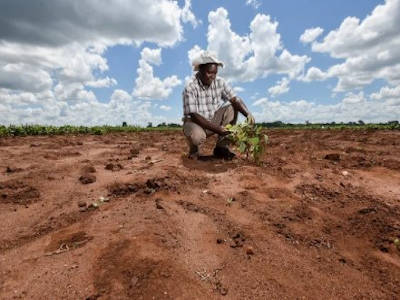There is a growing crisis beneath our feet. Scientists, soil specialists and policy-makers around the world are sounding the alarm about degrading soil conditions. And it is particularly stark in developing countries. In fact, about 40 per cent of soils in sub-Saharan Africa are already of poor quality.
Declining soil health causes poor crop yields, leading to further pressure on the soils as farmers struggle to meet food demands and eke out a living. Many farmers lack access to information or technologies to get out of this vicious cycle. If you are a farmer with the need to increase your yield in the face of these challenges, crop breeding and soil management offers a range of solutions as part of an Integrated Soil Fertility Management (ISFM) approach.
For instance, breeding programs which partner with CGIAR Excellence in Breeding (EiB) are working to deliver the best seed varieties for farmers to help them withstand harsh conditions and increase yields. Alongside this work, researchers are supporting farmers to adopt better agronomic practices, such as minimum tillage farming, crop rotation, proper spacing and planting date practices, the use of terracing or intercropping, or techniques to reduce water use.
Of course, breeding cannot happen in a vacuum. To protect soils and produce quality yields, these cropping measures should be closely matched to the best, context-appropriate soil management practices available to farmers, for instance around the type and timing of mineral fertilizer, along with organic sources like crop residues, compost or manure.
Indeed, a combination will bring the best results. But most of the time accessing either improved variety or best agronomic practice represent a challenge for farmers in low income countries.
Here are three ways crop breeders can ensure they deliver the best seeds and create the best conditions for long-term crop production.
Include farmers, agronomic experts and extension services when defining product requirements
Strong connections among public breeding programs and extension and agronomic groups are vital. There is growing discussion regarding how to broaden our work to better consider all the factors that contribute to a successful breeding scheme: genotyping, environment and management (GxExM). However, defining the management component is not easy. Do we breed for conditions that farmers are actually working with, or breed for conditions that they should adopt?
A key to answer this question is a strong breeding team defining the traits needed and wanted by farmers. To design the best product profile, it is imperative to involve extension teams and other groups that work on the development of sustainable agronomic practices.

A man inspects a drought-tolerant bean plant on a trial site in Malawi.
Properly manage research stations
Attention also needs to focus on the sustainability practices within research stations. It is all too easy to find degraded soil in public research stations. There are many reasons for this: inadequate long-term planning, lack of organized management structures, insufficient connections between breeding and agronomic teams, and lack of resources, to name a few.
Public research stations must serve as an example for the farmers in that specific region. Thus, it is not only what products we develop that matters, but also how we develop them. If we develop a good variety at the research station, but do so without adopting good agronomic practice, what example has been set for farmers and future generations? We need to ensure we invest in the best soil management practices along every step of the research phase.
Click here to see more...